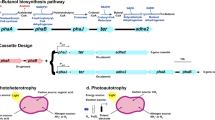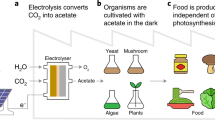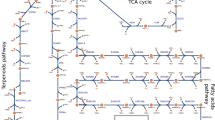Abstract
Global climate change has stimulated efforts to reduce CO2 emissions. One approach to addressing this problem is to recycle CO2 directly into fuels or chemicals using photosynthesis. Here we genetically engineered Synechococcus elongatus PCC7942 to produce isobutyraldehyde and isobutanol directly from CO2 and increased productivity by overexpression of ribulose 1,5-bisphosphate carboxylase/oxygenase (Rubisco). Isobutyraldehyde is a precursor for the synthesis of other chemicals, and isobutanol can be used as a gasoline substitute. The high vapor pressure of isobutyraldehyde allows in situ product recovery and reduces product toxicity. The engineered strain remained active for 8 d and produced isobutyraldehyde at a higher rate than those reported for ethanol1, hydrogen2 or lipid3 production by cyanobacteria or algae. These results underscore the promise of direct bioconversion of CO2 into fuels and chemicals, which bypasses the need for deconstruction of biomass.
This is a preview of subscription content, access via your institution
Access options
Subscribe to this journal
Receive 12 print issues and online access
$209.00 per year
only $17.42 per issue
Buy this article
- Purchase on Springer Link
- Instant access to full article PDF
Prices may be subject to local taxes which are calculated during checkout




Similar content being viewed by others
References
Deng, M.D. & Coleman, J.R. Ethanol synthesis by genetic engineering in cyanobacteria. Appl. Environ. Microbiol. 65, 523–528 (1999).
Tsygankov, A.A., Borodin, V.B., Rao, K.K. & Hall, D.O. H(2) photoproduction by batch culture of Anabaena variabilis ATCC 29413 and its mutant PK84 in a photobioreactor. Biotechnol. Bioeng. 64, 709–715 (1999).
Huntley, M.E. & Redalje, D.G. CO2 mitigation and renewable oil from photosynthetic microbes: a new appraisal. Mitig. Adapt. Strategies Glob. Change 12, 573–608 (2006).
Energy Information Administration. International Energy Outlook 2009. (US Department of Energy, Washington, DC, 2009) http://www.eia.doe.gov/oiaf/ieo/pdf/0484%282009%29.pdf.
Energy Information Administration Greenhouse Gases, Climate Change, and Energy. (US Department of Energy, Washington, DC, 2008) http://www.eia.doe.gov/bookshelf/brochures/greenhouse/greenhouse.pdf.
Ragauskas, A.J. et al. The path forward for biofuels and biomaterials. Science 311, 484–489 (2006).
Chisti, Y. Biodiesel from microalgae beats bioethanol. Trends Biotechnol. 26, 126–131 (2008).
Dutta, D., De, D., Chaudhuri, S. & Bhattacharya, S.K. Hydrogen production by Cyanobacteria. Microb. Cell Fact. 4, 36 (2005).
Tavano, C.L. & Donohue, T.J. Development of the bacterial photosynthetic apparatus. Curr. Opin. Microbiol. 9, 625–631 (2006).
Dubbs, J.M. & Tabita, F.R. Regulators of nonsulfur purple phototrophic bacteria and the interactive control of CO2 assimilation, nitrogen fixation, hydrogen metabolism and energy generation. FEMS Microbiol. Rev. 28, 353–376 (2004).
Wahlund, T.M., Conway, T. & Tabita, F.R. Bioconversion of CO2 to ethanol and other products. Am. Chem. Soc. Div. Fuel Chem. 41, 1403–1406 (1996).
Tyo, K.E., Zhou, H. & Stephanopoulos, G.N. High-throughput screen for poly-3-hydroxybutyrate in Escherichia coli and Synechocystis sp. strain PCC6803. Appl. Environ. Microbiol. 72, 3412–3417 (2006).
de la Plaza, M., Fernandez de Palencia, P., Pelaez, C. & Requena, T. Biochemical and molecular characterization of alpha-ketoisovalerate decarboxylase, an enzyme involved in the formation of aldehydes from amino acids by Lactococcus lactis. FEMS Microbiol. Lett. 238, 367–374 (2004).
Bustos, S.A. & Golden, S.S. Light-regulated expression of the psbD gene family in Synechococcus sp. strain PCC 7942: evidence for the role of duplicated psbD genes in cyanobacteria. Mol. Gen. Genet. 232, 221–230 (1992).
Golden, S.S., Brusslan, J. & Haselkorn, R. Genetic engineering of the cyanobacterial chromosome. Methods Enzymol. 153, 215–231 (1987).
Atsumi, S., Hanai, T. & Liao, J.C. Non-fermentative pathways for synthesis of branched-chain higher alcohols as biofuels. Nature 451, 86–89 (2008).
Andersson, C.R. et al. Application of bioluminescence to the study of circadian rhythms in cyanobacteria. Methods Enzymol. 305, 527–542 (2000).
Ikawa, M., Sasner, J.J. & Haney, J.F. Inhibition of Chlorella growth by degradation and related products of linoleic and linolenic acids and the possible significance of polyunsaturated fatty acids in phytoplankton ecology. Hydrobiologia 356, 143–148 (1997).
Watson, G.M. & Tabita, F.R. Microbial ribulose 1,5-bisphosphate carboxylase/oxygenase: a molecule for phylogenetic and enzymological investigation. FEMS Microbiol. Lett. 146, 13–22 (1997).
Tcherkez, G.G., Farquhar, G.D. & Andrews, T.J. Despite slow catalysis and confused substrate specificity, all ribulose bisphosphate carboxylases may be nearly perfectly optimized. Proc. Natl. Acad. Sci. USA 103, 7246–7251 (2006).
Smith, S.A. & Tabita, F.R. Positive and negative selection of mutant forms of prokaryotic (cyanobacterial) ribulose-1,5-bisphosphate carboxylase/oxygenase. J. Mol. Biol. 331, 557–569 (2003).
Woodrow, I.E. & Berry, J.A. Enzymatic regulation of photosynthetic CO2 fixation in C3 plants. Annu. Rev. Plant Physiol. Plant Mol. Biol. 39, 533–594 (1988).
John Andrews, T. & Whitney, S.M. Manipulating ribulose bisphosphate carboxylase/oxygenase in the chloroplasts of higher plants. Arch. Biochem. Biophys. 414, 159–169 (2003).
Suzuki, Y. et al. Increased Rubisco content in transgenic rice transformed with the 'Sense' rbcS Gene. Plant Cell Physiol. 48, 626–637 (2007).
Whitney, S.M. & Andrews, T.J. Plastome-encoded bacterial ribulose-1,5-bisphosphate carboxylase/oxygenase (RubisCO) supports photosynthesis and growth in tobacco. Proc. Natl. Acad. Sci. USA 98, 14738–14743 (2001).
Miyagawa, Y., Tamoi, M. & Shigeoka, S. Overexpression of a cyanobacterial fructose-1,6-/sedoheptulose-1,7-bisphosphatase in tobacco enhances photosynthesis and growth. Nat. Biotechnol. 19, 965–969 (2001).
Ma, W., Shi, D., Wang, D., Wei, L. & Chen, H. Exogenous expression of the wheat chloroplastic fructose-1,6-bisphosphatase gene enhances photosynthesis in the transgenic cyanobacterium, Anabaena PCC7120. J. Appl. Phycol. 17, 273–280 (2005).
Atsumi, S. et al. Engineering the isobutanol biosynthetic pathway in Escherichia coli by comparison of three aldehyde reductase/alcohol dehydrogenase genes. Appl. Microbiol. Biotechnol. published online, doi:10.1007/s00253-009-2085-6 (16 July 2009).
Sulzenbacher, G. et al. Crystal structure of E.coli alcohol dehydrogenase YqhD: evidence of a covalently modified NADP coenzyme. J. Mol. Biol. 342, 489–502 (2004).
Happe, T., Schutz, K. & Bohme, H. Transcriptional and mutational analysis of the uptake hydrogenase of the filamentous cyanobacterium Anabaena variabilis ATCC 29413. J. Bacteriol. 182, 1624–1631 (2000).
Laurinavichene, T., Tolstygina, I. & Tsygankov, A. The effect of light intensity on hydrogen production by sulfur-deprived Chlamydomonas reinhardtii. J. Biotechnol. 114, 143–151 (2004).
Phlips, E.J. & Mitsui, A. Role of light intensity and temperature in the regulation of hydrogen photoproduction by the marine cyanobacterium Oscillatoria sp. strain Miami BG7. Appl. Environ. Microbiol. 45, 1212–1220 (1983).
Ivleva, N.B., Bramlett, M.R., Lindahl, P.A. & Golden, S.S. LdpA: a component of the circadian clock senses redox state of the cell. EMBO J. 24, 1202–1210 (2005).
Yang, Y.T., Peredelchuk, M., Bennett, G.N. & San, K.Y. Effect of variation of Klebsiella pneumoniae acetolactate synthase expression on metabolic flux redistribution in Escherichia coli. Biotechnol. Bioeng. 69, 150–159 (2000).
Kiritani, K., Narise, S. & Wagner, R.P. The dihydroxy acid dehydratase of Neurospora crassa. J. Biol. Chem. 241, 2042–2046 (1966).
Cioffi, E.A., Shaw, K.J., Bailey, W.F. & Berg, C.M. Improved synthesis of the sodium salt of DL-alpha, beta-dihydroxyisovaleric acid. Anal. Biochem. 104, 485–488 (1980).
Whitman, W. & Tabita, F.R. Inhibition of D-ribulose 1,5-bisphosphate carboxylase by pyridoxal 5′-phosphate. Biochem. Biophys. Res. Commun. 71, 1034–1039 (1976).
Acknowledgements
This work was supported in part by US Department of Energy (DOE) grant DE-FG02-07ER64490 and the UCLA-DOE Institute for Genomics and Proteomics. We thank S.S. Golden (University of California, San Diego) for S. elongatus PCC7942 and pAM2991, F.R. Tabita (Ohio State University, Columbus) for the rbcLS plasmid and L.A. Sherman (Purdue University) for helpful advice.
Author information
Authors and Affiliations
Contributions
S.A. designed and performed research, analyzed data and wrote the manuscript; W.H. designed and performed research and analyzed data; J.C.L. designed and coordinated research, and wrote the manuscript.
Corresponding author
Supplementary information
Supplementary Text and Figures
Supplementary Figs. 1–3, Supplementary Tables 1,2 and Supplementary Notes (PDF 553 kb)
Rights and permissions
About this article
Cite this article
Atsumi, S., Higashide, W. & Liao, J. Direct photosynthetic recycling of carbon dioxide to isobutyraldehyde. Nat Biotechnol 27, 1177–1180 (2009). https://doi.org/10.1038/nbt.1586
Received:
Accepted:
Published:
Issue Date:
DOI: https://doi.org/10.1038/nbt.1586
This article is cited by
-
CO2 capture by modified clinoptilolite and its regeneration performance
International Journal of Coal Science & Technology (2024)
-
Two modules for biosynthesis from CO2
Nature Synthesis (2023)
-
Nanoparticles Treat Ischemic Stroke by Responding to Stroke Microenvironment
BioNanoScience (2023)
-
Expressing 2-keto acid pathway enzymes significantly increases photosynthetic isobutanol production
Microbial Cell Factories (2022)
-
Light-induced production of isobutanol and 3-methyl-1-butanol by metabolically engineered cyanobacteria
Microbial Cell Factories (2022)



